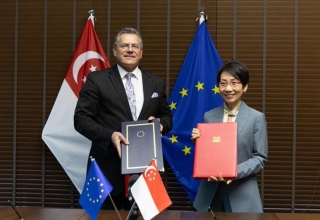
June was the ninth consecutive month of continuous reductions for Singapore’s non-oil domestic exports (NODX). According to the most recent data, both the electronics and non-electronics industries witnessed a fall, resulting in a reduction of 15.5 per cent. This negative trend comes after decreases of 14.8%% in May and 9.88%% in April. Even though the June statistics marginally exceeded expectations, the ongoing decline in NODX raises questions about Singapore’s economy.
Electronics Sector Decline
Exports of electronic products decreased by 15.9% per cent in June, following a dramatic 27.2 per cent drop in May, according to information made public by Enterprise Singapore (EnterpriseSG). Integrated circuits (ICs), personal computers (PCs), and PC parts were the electronics sub-sectors that were hardest hit, with drops of 31.8 per cent, 44.2 per cent, and 44.8 per cent, respectively. These numbers indicate a considerable slowdown in the demand for Singapore’s electronic goods on the international market.
Non-Electronics Sector Challenges
Exports from the non-electronics industry also saw a downturn, falling by 15.4% in June after falling by 10.7% in May. Notably, the sectors that experienced the most significant drops were petrochemicals, pharmaceuticals, and primary chemicals, which decreased by 34%, 29.54%, and 61.84%, respectively. These reductions show diminishing demand and the challenging global economic environment these sectors operate in.
Key Market Challenges
The difficult conditions in essential markets made the decrease in NODX worse. The major contributors to the shrinkage were Malaysia, Indonesia, and South Korea, which had notable drops of 30.7 per cent, 35.7 per cent, and 24.2 per cent, respectively. These numbers demonstrate how Singapore’s exports are susceptible to changes in neighbouring nations’ demand, notably in the Southeast Asian region.
Singapore’s total commerce shrank 17.9 per cent in May and 19.2 per cent in June compared to last year. Exports and imports significantly dropped 17.2% and 21.4%, respectively. These numbers reflect that there has been a general slowdown in global trade and that Singapore’s external trading environment is growing more complex.
Keep Reading
Economic Outlook and Recession Concerns
Singapore narrowly avoided a technical recession with its weak quarterly growth of 0.3%, according to early projections for the second quarter. However, the ongoing decline in NODX and overall trade raises questions about whether Singapore’s economic growth can withstand external pressures. Geopolitical unrest, the global economic slump, and supply-chain interruptions have all added to the difficulties Singapore’s export-driven economy is currently experiencing.
Along with dropping trade data, Singapore’s non-oil domestic exports have declined for the ninth consecutive month, indicating that the nation’s economy is still facing difficulties. The decrease in Singapore’s electronics and non-electronics sectors, along with the challenges in essential markets, highlight how susceptible the island nation’s export-based economy is to global economic uncertainty. Moving forward, officials must concentrate on expanding domestic sectors and diversifying Singapore’s export markets to reduce the dangers brought on by its reliance on foreign demand.























